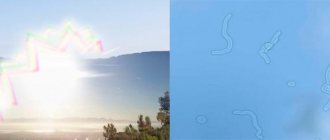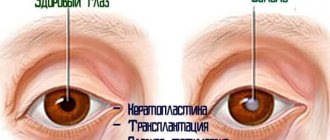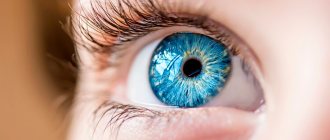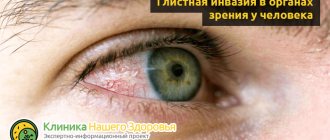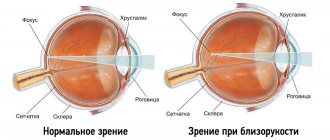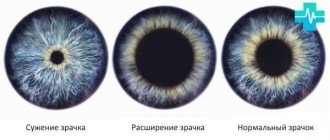Blennorrhea: causes, types, symptoms, diagnosis, treatment and prevention Blennorrhea - related to acute purulent inflammation of the mucous membrane - conjunctiva of the eyes, very often caused by gonococcus - gonoblennorrhea. It often occurs in newborns who become infected from a sick mother during childbirth.
Causes
A common pathogen is gonococcus, sometimes in association with chlamydia. A third of the ailments are caused by streptococcal and pneumococcal infections, E. coli, and groups of mixed harmful microbes.
Babies are affected during labor when the fetal head passes through the infected birth canal. Sometimes the fetus becomes infected right in the womb. This happens when the amniotic sac dilates earlier than normal, or the labor process is delayed. After birth, infection can occur through hands, water, hygiene items due to improper care or poor disinfection.
Adults become ill if they already have gonorrhea when the organism is accidentally introduced into the eye.
What you need to know about gonococcal conjunctivitis in children
Gonococcal conjunctivitis is a disease that affects both eyes. Occurs as a result of intrauterine infection or improper hygiene after birth. It is also transmitted through the birth canal from a sick mother. The causative agent is gonococcus. The mucous membrane of the newborn's eye is severely affected. It may become thinner, after which bacteria affect the cornea of the eye, causing irreversible consequences.
The disease does not appear immediately after infection, and the first signs are obvious after two to three days (more often the infection is noticed in the maternity hospital). The source of spread is the bacterium gonococcus, which affects the mother, or unsanitary conditions in the delivery room.
Blenorrhea in newborns is accompanied by scanty purulent discharge from the eyes a few days after infection
Frequently asked questions to doctors
Methods of transmission of the disease
Is it possible to get gonorrhea from a sick person through a kiss?
Gonorrhea is an infectious disease, mainly transmitted through sexual contact (vaginal, oral, anal). Outside the body, pathogens cannot live long; a dry environment is also dangerous for microorganisms. However, if gonorrhea of the pharynx develops, it can be transmitted in everyday life. If you have had any contact with a sick person, even a kiss, I recommend that you go to the hospital and get examined.
Symptoms of concern
Blenorrhea always manifests itself in a newborn in the same way; it is characterized by the following symptoms:
- severe thickening of the eyelids, redness of the skin around the eyes;
- it is difficult to open the baby’s eyes for examination;
- the conjunctiva becomes loose, often accompanied by bleeding;
- copious serous discharge, discharge of pus;
- eyelids stick together and dry out;
- the newborn becomes capricious;
- Premature newborns develop a fever.
Note! A complex form of gonoblennorrhea in newborns often requires hardware opening of the eyelids for diagnostic examination and treatment. After a few days, the eyes open easily on their own.
Diagnostic methods
Before starting treatment, correct diagnosis is required. A study of discharge from the eyes of a newborn is carried out in laboratory conditions. If gonococcus is present in the test results, blenorrhea is confirmed.
Ophthalmoblennorrhea is determined by direct examination of the eyes of a newborn. It is important not to confuse blenorrhea with purulent conjunctivitis or dacryocystitis. Therefore, you need to seek help from a competent ophthalmologist.
At the same time, pathology of the cornea of the eyeball is excluded; for this, the newborn is prescribed biomicroscopy, diaphanoscopy, and a fluorescein installation test.
To confirm blenorrhea in a newborn baby, discharge from the eyes is taken for analysis.
What is hardware eyelid opening?
If the baby cannot open the eyes stuck together from pus using a conservative method, then they resort to the hardware method. To do this, a special instrument is used to penetrate under the baby’s upper eyelid and pierce the dense purulent sac.
The drug Sulfacyl Sodium is also used in the treatment of benorrhea in newborns; it is also used before and after hardware opening of the eyelids.
This procedure is recommended to be performed once, as there is a risk of reocclusion of the newborn's eyes. After successful opening, the eyeball is cleansed of serous masses with antiseptics.
Drug therapy for gonococcal eye infections in children
Several types of medications are used to treat blenorrhea in newborns and babies up to one year old.
Note to moms! Before use, local antiseptic preparations must be diluted with water, since these products are concentrated and can cause allergic reactions. The medicine should be diluted in a ratio of 3 drops to 1 tbsp. l. boiled water.
Taking medications
The course of treatment is individual for each little patient. The dosage of medications depends on the age of the newborn and is prescribed by the doctor.
The first step in the treatment of blenorrhea in newborns is washing the eyes with an antiseptic.
Treatment of blenorrhea in a child under one year of age is carried out in strict sequence:
- They wash the eyes and remove the purulent secretion using a solution of Furacilin or a similar product (Miramistin, Chlorhexedine, Levomycitin). Leave for a few minutes, then remove the purulent contents with a cotton swab. If it is not possible to open the eyelids with your own hands, they resort to hardware opening.
- Next, two drops of Albucid (Sodium Sulfacyl) are instilled into each eye of the child, and after 1-2 hours the procedure is repeated. After 30 minutes, instill Tobrodex diluted with water for injection, 1 drop into each eye.
- After a few hours, if these methods fail to alleviate the baby’s condition, tetracycline ointment is placed under the child’s upper eyelid. The product is used at least twice a day.
- Your baby may be prescribed medications in the form of injections. Cefotaxime is prescribed at a dosage of 1 g every 8 hours for three days. It is advisable not to prolong treatment with this drug, as it accumulates in the body and can cause complications. An intramuscular injection of Ceftriaxone is also given at a dosage of 25 mg/kg body weight. Injections are given for at least three days.
- The final stage of treatment is the use of antibiotics. For newborns with blenorrhea, they are prescribed when the disease is acute and severe. Prescribe Ampicillin or Flemoxin Solutab in the form of suspensions.
Eye ointments are used to accompany therapy for the diagnosis of blenorrhea in newborns.
Traditional therapy for blenorrhea
From a medical point of view, it is prohibited to use folk remedies to treat diseases of the visual organs. They do not bring the desired result and are used only as additional ones. Based on some medicinal herbs, you can prepare a decoction for washing the eyes after drug treatment. To do this, use pharmaceutical chamomile, ripe rose hips, fresh dill seeds, and strong tea leaves.
Children say! My son (4 years old) was with his grandparents for a long time, got bored, and told them: “I’m worried about my mother.”
Doctors urge parents not to use herbal decoctions to wash the eyes of newborns without an examination by an ophthalmologist. These actions often contribute to the spread of infection, especially if hygiene is not observed during the procedure.
Advice! At home, to alleviate the condition of a newborn diagnosed with gonoblenorrhea, it is recommended to wash the eyes with warm boiled water three to four times a day. This procedure must also be done during the rehabilitation process.
Treatment
During therapy, you may need an additional appointment with a dermatovenerologist, as well as a pediatrician.
The treatment strategy involves destruction of the pathogen and local therapy. The conjunctival area is washed with a solution of potassium permanganate, after which medicinal preparations are instilled. While the patient sleeps, a special anti-germ ointment is applied to the areas behind the eyelids. A bandage is applied to protect the other eye. The patient takes antibacterial agents; in some cases, intramuscular injections are possible. Two weeks after a set of therapeutic measures, a control smear is performed.
Complications of blenorrhea
When there is no treatment or an incorrect diagnosis, gonococcal conjunctivitis in infants develops into complications, often irreversible for health. Extensive damage to the cornea occurs, cloudy spots and ulcers on the eyeballs are noticed. The pus then moves into the remaining tissues of the eye, causing its death.
If this process is not stopped, gonococci move into the newborn's bloodstream, damaging joints and causing gonococcal arthritis. This pathology is accompanied by hyperthermia and aching joints.
In order to protect the child from complications of blenorrhea, eye drops with the antibiotic Tobradex are prescribed
Source of infection and routes of transmission of gonorrhea
The gonorrheal pathogen is transmitted sexually during genital contact.
Transmission of the disease occurs even if the microbe has not yet begun to actively multiply in the body and cause the corresponding symptoms. When gonorrhea appears in a man's body, inflammation of the urethra occurs. A woman first of all faces problems with the functioning of the urethra. The gonococcus then infects the vagina and cervical canal. In homosexuals, the focus of infection is the rectum, where gonococcus begins to actively multiply. Therefore, a man must protect himself even during same-sex sexual intercourse. In little girls, gonococci can also be found in the rectum; this fact is explained by the fact that the genitals become so inflamed that, due to the secretions, the parasites begin to attack another place.
The route of transmission of gonorrhea is not limited to genital contact, since infection can also occur during oral sex. In this case, the infectious pathogen will affect the mucous membrane of the pharynx, tonsils and mouth. Experts have different opinions, but some believe that you can get gonorrhea even by kissing.
Prevention of ophthalmoblennorrhea in a child
You can reduce the risk of infecting a newborn baby with blenorrhea by following the algorithm that complies with SanPin:
- Labor must be carried out under sterile conditions for both mother and newborn. Sick nurses, doctors and midwives are not allowed to work.
- If a mother is a carrier of gonorrhea during pregnancy, she must be treated in the second trimester, otherwise there is a risk of congenital blennorrhea in the newborn.
- Before childbirth, as a preventative measure, the mother is sanitized under the supervision of an experienced gynecologist.
- After the baby is born, Sodium Sulfacyl or Silver Nitrate 2% must be instilled into his eyes to prevent the occurrence of ophthalmoblennorrhea.
- Newborn care items are sterilized, even if they are new.
At the end of the article, watch a video that talks about the risks of blenorrhea and what prevention should be.
Emergency measures
If women have entered into a relationship with an unfamiliar man without using contraception, and they are afraid that they may become infected with gonorrhea or another disease, it is necessary to take emergency preventive measures:
- Empty your bladder several times;
- The inner thighs and external genitalia must be treated with warm water and soap;
- a solution of Betadine and Miramistin must be injected into the urethra (2 millimeters), as well as into the vagina 5 millimeters, no more than two hours should pass after contact;
- The inner thighs and perineum must be treated with an antiseptic, for example, Chlorhexidine, Miramistin.
You should visit a venereologist within the first 48 hours. The specialist will conduct an examination and write out a recommended treatment plan. The photo below is an example of how preventative care takes place.
Hygiene measures are carried out


